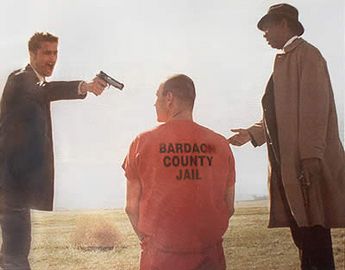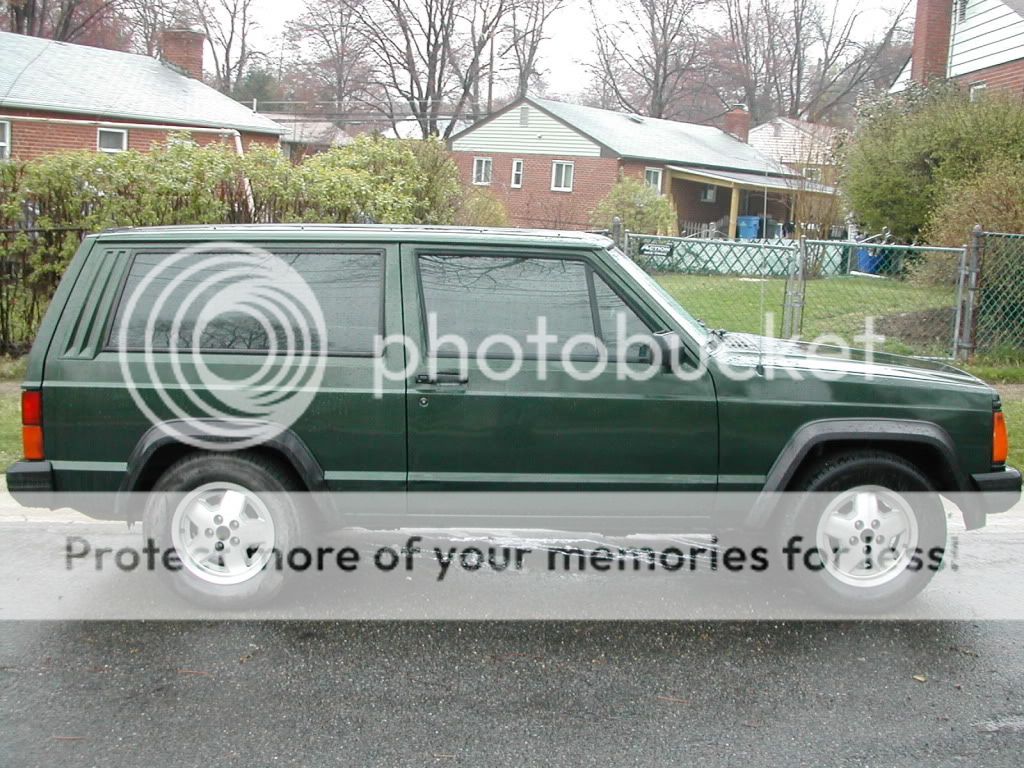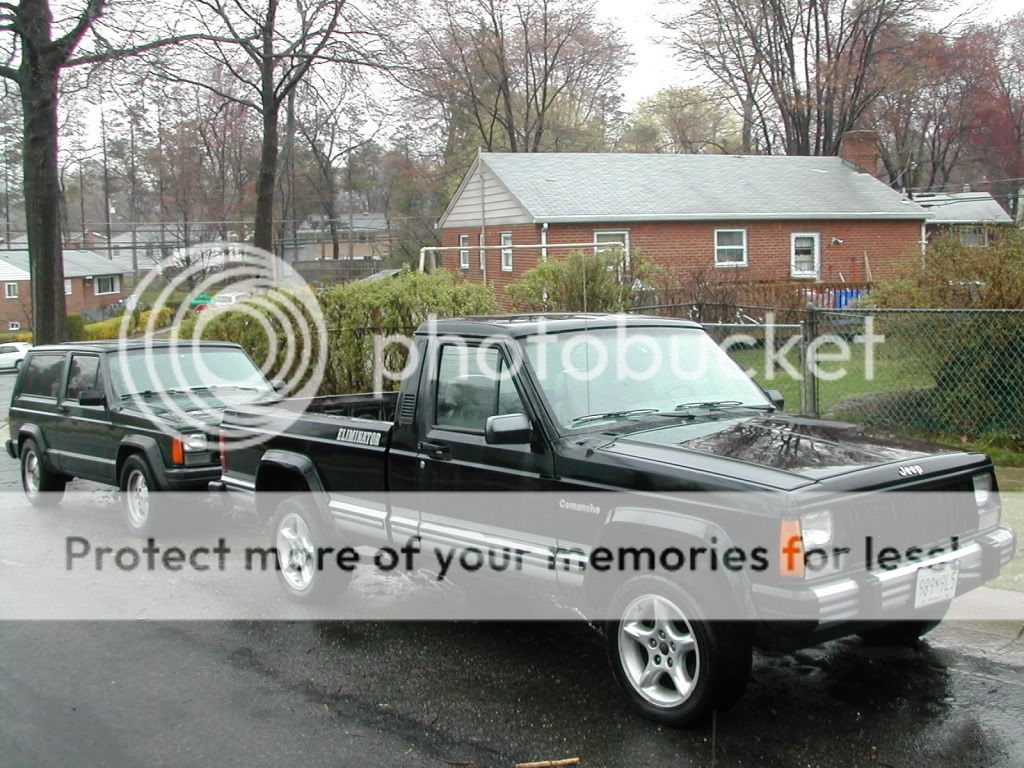IXNAYXJ
NAXJA Forum User
- Location
- Wherever the next race is.
A while back on another XJ forum, I was asked a series of questions on how I lowered my 24 Hour of LeMons XJ. I ended up spending some time answering a bunch of this guy's questions in depth so I figured I'd post the salient parts of that thread here too. I was writing to relatively inexperienced group, so I went into very specific detail. His questions in bold, my responses following:
Q: Am I going in the right direction? Cut coils in front and leaf under axle in rear? (the leafs will be brand new when i do the conversion)
I played around with a variety of different options and came to this one mainly for simplicity reasons. Sort of by accident I got a extremely good handling set-up. You will have to add some lift to the rear springs to match the front. Going spring under will lower the rear between 5-6 inches, more than you can get out of the front. We added a Rubicon Express 2" add-a-leaf and it worked out perfectly, and stiffened up the rear end up quite a bit. Depending on what rear axle you have results will vary slightly because the thinker the axle tube OD, the lower the Jeep will sit. D35 and D44 and both pretty small diameter, 8.25 slightly larger, and the 8.8 we run is largest still (I think 3.25").
Q: Are there any suggestions you have or ideas regarding a better approach?
Just copy me, it works, it's easy, and it actually drives awesome. I don't mean to sound arrogant, it's just that I know beyond a shadow of a doubt this set up works flawlessly.
Q: How many coils can I cut for maximum drop(looking to have it sitting right above the tire or slightly tucked). Also what shocks did you use in the Petty machine?
I think we cut just over a full coil out (maybe 1.5?), but I honestly can't remember. I do know we couldn't get the axle to droop enough with the steering attached to get the coil out, so we just cut 'em in place. Worked great and saved some work:
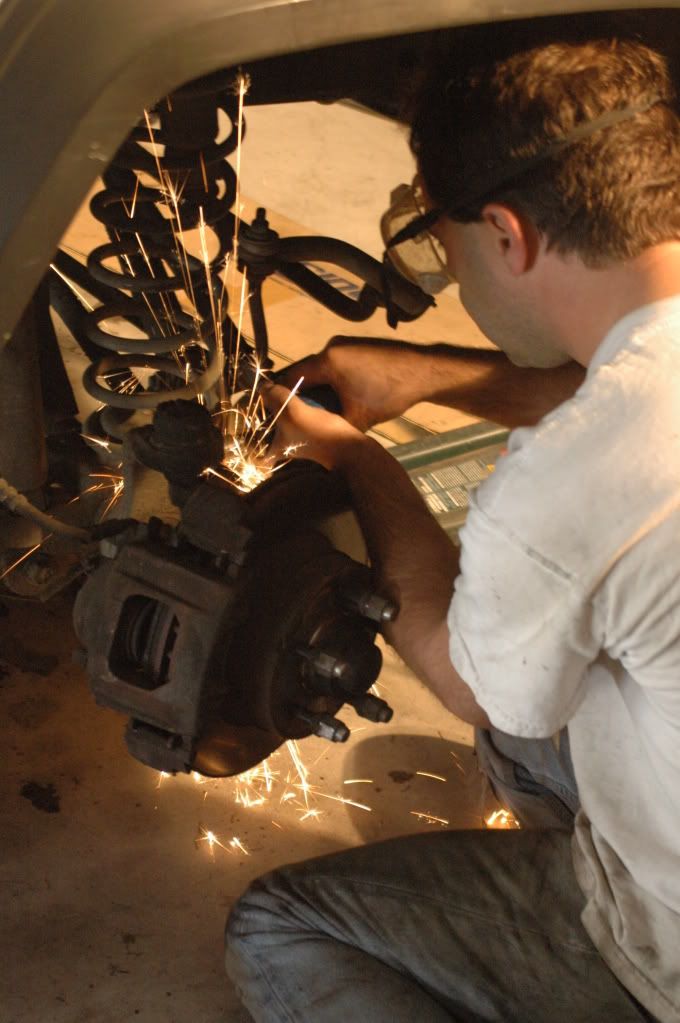
Couple things to keep in mind; use a cut-off wheel, not a torch. The heat will effect the metal and change the rate adversely. Also, we weigh in at ~2900 lbs. If you keep the full interior or have a bunch stereo gear, spare tire, etc in it, it will ride lower due to the heavier curb weight. All we really did was strip the easy stuff out of the interior, but I think we added that much weight back in with the cage:
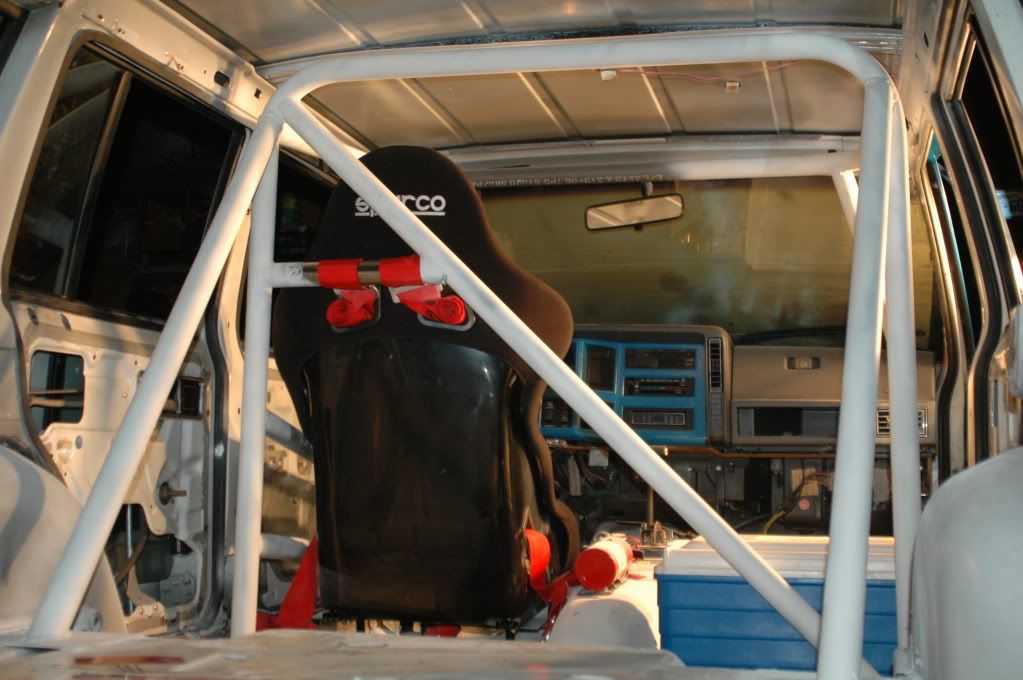
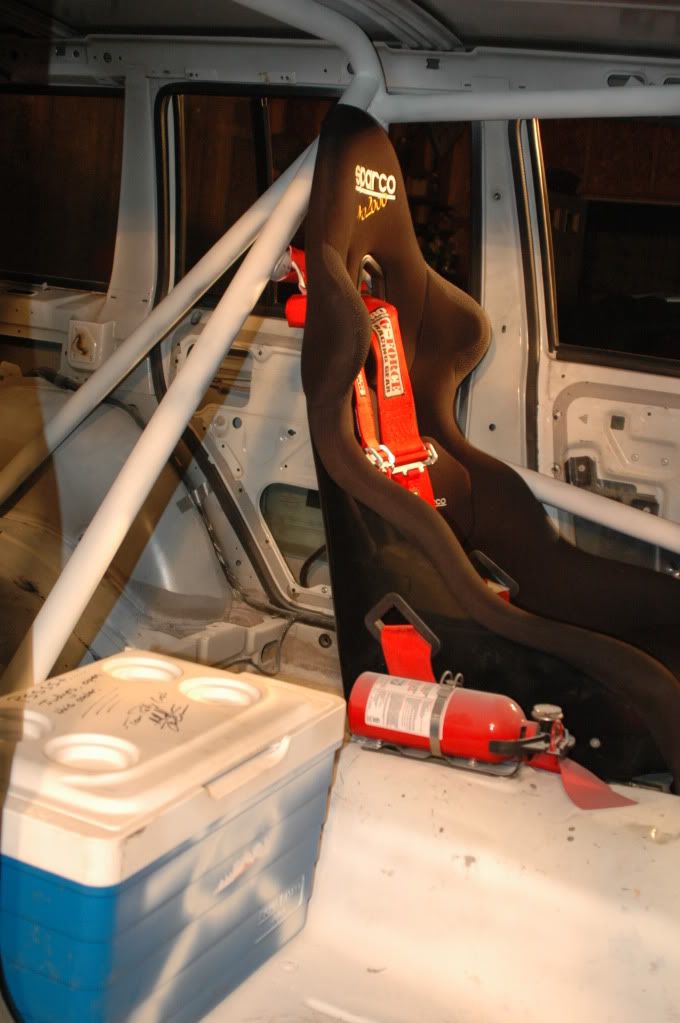
Q:I have one main concern about clearance from the control arm brackets.. its seem if i go down enough i will have issues of the bracket hitting the engine mount.
You will not be able to go much lower than what we have because the oil pan will start to have clearance issues with the front axle, and you will run into steering geometry problems. Unless you want to notch and truss the front axle (it has been done), run adjustable control arms and custom steering, this is about as low as you can go. For 99% of people, it's not worth the time and effort, IMHO.
If what you're looking for is purely appearance, the steering and road manners might not matter as much, but we wanted the Jeep to handle and steer well above all other considerations. Lower does not automatically equal better handling. Where she sits now, there's very little body roll and it's very composed on the road and race track.
We're running the newish generic shocks that came with the Jeep when I bought it for $200 and stock sway bars too. New OME or Bilsteins are on the way before the next race, but I don't think they'll really make that much of a difference; one of my rear shocks came loose from the axle and I raced the last 2 hours that way without any noticable adverse handling traits. We're really probably only 2.5"-3" lower than stock.
Q: What would be the overall difficulty of this project?
The biggest challenge is relocating the rear spring perches/shock and sway bar mounts. We did it the wrong way that worked, but it kinda sketchy the first time. I would not reccommend this way; we just plasma torched off the stock mounts, flipped and reversed them and welded them back on. It worked, but it's not the ideal way.
When we went to the 8.8 we had to fab new ones. The 8.8 is sprung under on the Explorer donor, but the distance between the perches was wrong and there was no easy way to make them work due to shock angles and some other stuff. We cannibalized some Comanche MJ (sprung under to begin with) spring plates and fabbed up our mounts, then burned them onto the axle.
This really the only part that is tricky and requires a little welding/fab skill. Do some CAD (Cardboard Aided Design) mock-ups then build 'em. While you're there, you can also do a couple stiches where the axle tube meets the center section; 8.8's are notorious for spinning axle tubes, but for a street application, it's not at all necessary.
If you're looking to fill up the wheel well more than we have it, go to a 17" wheel with a decent sidewall aspect ratio and it should look "better," tuner style. Hope that helped, feel free to ask any more questions if you need clarification.
Here is a picture of how the rig looked on stock little 15" A/Ts:
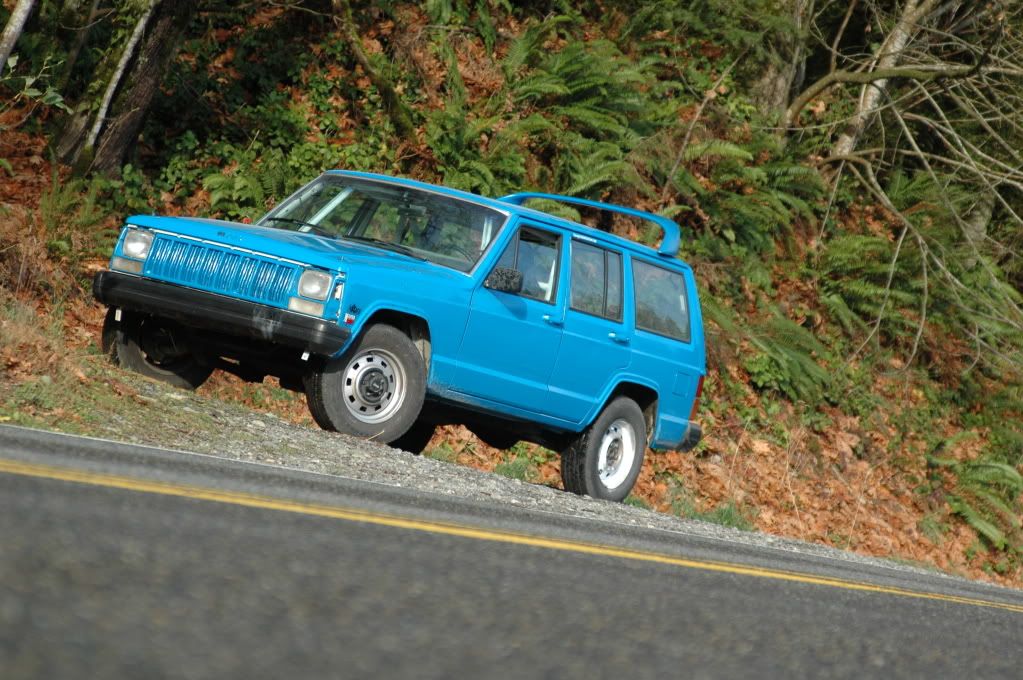
Here it is with 245/50R16 Toyo Proxes4's at our first race at Thunderhill:
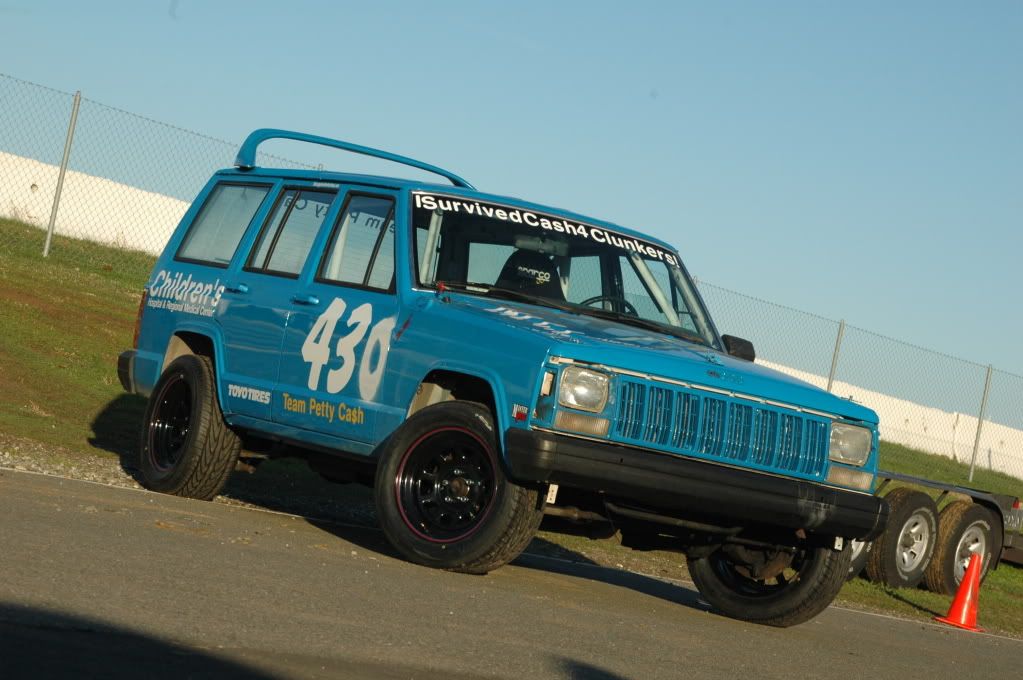
We also have a bunch of in-car videos that you can see on our YouTube Channel that will give you an idea of the speeds we were reaching (up to about 105 mph) and how stable and quick our race XJ really is. Enjoy!
Feel free to ask any questions that you still have on our car in particular, or our experiences in lowering the XJ.
-Matt
Petty Cash Racing
Q: Am I going in the right direction? Cut coils in front and leaf under axle in rear? (the leafs will be brand new when i do the conversion)
I played around with a variety of different options and came to this one mainly for simplicity reasons. Sort of by accident I got a extremely good handling set-up. You will have to add some lift to the rear springs to match the front. Going spring under will lower the rear between 5-6 inches, more than you can get out of the front. We added a Rubicon Express 2" add-a-leaf and it worked out perfectly, and stiffened up the rear end up quite a bit. Depending on what rear axle you have results will vary slightly because the thinker the axle tube OD, the lower the Jeep will sit. D35 and D44 and both pretty small diameter, 8.25 slightly larger, and the 8.8 we run is largest still (I think 3.25").
Q: Are there any suggestions you have or ideas regarding a better approach?
Just copy me, it works, it's easy, and it actually drives awesome. I don't mean to sound arrogant, it's just that I know beyond a shadow of a doubt this set up works flawlessly.
Q: How many coils can I cut for maximum drop(looking to have it sitting right above the tire or slightly tucked). Also what shocks did you use in the Petty machine?
I think we cut just over a full coil out (maybe 1.5?), but I honestly can't remember. I do know we couldn't get the axle to droop enough with the steering attached to get the coil out, so we just cut 'em in place. Worked great and saved some work:

Couple things to keep in mind; use a cut-off wheel, not a torch. The heat will effect the metal and change the rate adversely. Also, we weigh in at ~2900 lbs. If you keep the full interior or have a bunch stereo gear, spare tire, etc in it, it will ride lower due to the heavier curb weight. All we really did was strip the easy stuff out of the interior, but I think we added that much weight back in with the cage:


Q:I have one main concern about clearance from the control arm brackets.. its seem if i go down enough i will have issues of the bracket hitting the engine mount.
You will not be able to go much lower than what we have because the oil pan will start to have clearance issues with the front axle, and you will run into steering geometry problems. Unless you want to notch and truss the front axle (it has been done), run adjustable control arms and custom steering, this is about as low as you can go. For 99% of people, it's not worth the time and effort, IMHO.
If what you're looking for is purely appearance, the steering and road manners might not matter as much, but we wanted the Jeep to handle and steer well above all other considerations. Lower does not automatically equal better handling. Where she sits now, there's very little body roll and it's very composed on the road and race track.
We're running the newish generic shocks that came with the Jeep when I bought it for $200 and stock sway bars too. New OME or Bilsteins are on the way before the next race, but I don't think they'll really make that much of a difference; one of my rear shocks came loose from the axle and I raced the last 2 hours that way without any noticable adverse handling traits. We're really probably only 2.5"-3" lower than stock.
Q: What would be the overall difficulty of this project?
The biggest challenge is relocating the rear spring perches/shock and sway bar mounts. We did it the wrong way that worked, but it kinda sketchy the first time. I would not reccommend this way; we just plasma torched off the stock mounts, flipped and reversed them and welded them back on. It worked, but it's not the ideal way.
When we went to the 8.8 we had to fab new ones. The 8.8 is sprung under on the Explorer donor, but the distance between the perches was wrong and there was no easy way to make them work due to shock angles and some other stuff. We cannibalized some Comanche MJ (sprung under to begin with) spring plates and fabbed up our mounts, then burned them onto the axle.
This really the only part that is tricky and requires a little welding/fab skill. Do some CAD (Cardboard Aided Design) mock-ups then build 'em. While you're there, you can also do a couple stiches where the axle tube meets the center section; 8.8's are notorious for spinning axle tubes, but for a street application, it's not at all necessary.
If you're looking to fill up the wheel well more than we have it, go to a 17" wheel with a decent sidewall aspect ratio and it should look "better," tuner style. Hope that helped, feel free to ask any more questions if you need clarification.
Here is a picture of how the rig looked on stock little 15" A/Ts:

Here it is with 245/50R16 Toyo Proxes4's at our first race at Thunderhill:

We also have a bunch of in-car videos that you can see on our YouTube Channel that will give you an idea of the speeds we were reaching (up to about 105 mph) and how stable and quick our race XJ really is. Enjoy!
Feel free to ask any questions that you still have on our car in particular, or our experiences in lowering the XJ.
-Matt
Petty Cash Racing

